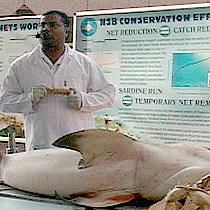2007年VOA标准英语-Protective Nets Keep Sharks at Bay in Durban, S(在线收听)
Durban
14 June 2007
South Africa boasts some of the most beautiful beaches in the world, which attract millions of tourists each year. A series of fatal shark attacks in the Durban area in the 1940s led local authorities to install shark nets to protect swimmers. These have reduced the number of serious shark attacks to almost none but the nets also kill harmless marine species, some of which are threatened. Correspondent Scott Bobb has this report from the southeast city of Durban on efforts to reduce the environmental impact of the nets.
 |
| Geremy Cliff |
The nets are 200 to 300 meters long and anchored 400 meters from shore. They protect some 40 kilometers of the most popular beaches in the area. They have reduced the number of serious shark attacks since the 1940s to virtually none.
Director Cliff says that the nets are only six meters deep. As a result they do not act as a barrier and prevent sea animals from approaching the shore. "The shark nets are simply fishing devices. And should a shark spend a lot of time inshore it's more than likely going to encounter a net and be caught."
Maintaining the net is labor intensive. Each net is inspected daily and must be replaced and cleaned every two weeks. Heavy seas can damage the nets or carry them out to sea.
A more recent challenge comes from environmentalists who object that the nets also kill animals that are not a threat to humans. Other coastal regions, like Capetown, do not use shark nets. Cliff says, "We also catch animals such as dolphins and turtles. We don't want to do that. And as a result we've had to introduce a number of initiatives to reduce what we would term the by-catch, the catch of non-target animals."
To reduce the by-catch the Sharks Board in some areas has replaced shark nets with drum lines. These are buoys with a line and a large hook that catches only big fish. Scientists are also experimenting with electronic devices that repel sharks, and others that warn dolphins of the nets.
Cliff says the Board walks a fine line between opponents and supporters of the program. "Our philosophy is quite simple in that we believe that people who come to a small section of the coastline are entitled to be protected against shark attack. (But) We will do everything that we can to try to minimize environmental impact."
Any animals caught alive, including sharks, are tagged and set free.
 |
| Dead sharks are used for educational presentations |
The program seeks to educate people about sharks' behavior. It teaches them to avoid swimming at night or at dawn when sharks often feed.
The Shark Board's mission is to protect human life and the all-important tourism industry. At the same time it seeks to better understand these wonderful, although sometimes dangerous, creatures of the sea.